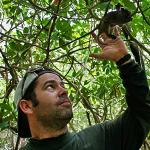
Maikel Cañizares Morera, MSc.
Maikel is an expert ornithologist at the Cuban Institute of Ecology and Systematics. He was President of the Cuban Zoological Society from 2014 to 2019, President of the Cuban Chapter of the Mesoamerican Society for Biology and Conservation from 2010 to 2017, and President at large of BirdsCaribbean since 2020. Maikel is a conservationist, researcher, educator, and wildlife photographer with 25 years of professional experience managing biodiversity conservation projects in partnership with NGOs and donor agencies worldwide.
Maikel has extensive experience in avian ecology, with a special interest in cavity-nesting birds. He has pioneered the use of artificial nest boxes to support the recovery of psittacid populations in Cuba and other Latin American countries. He has focused on citizen science projects involving people from rural communities as key stakeholders in effective biodiversity management and conservation, training protected area technicians, rangers, and campesinos. He has taught biology students at the Havana and Martha Abreu Universities, has published several conservation and research papers, and is a chapter author of six books. He has also led dozens of expeditions to the most remote areas in Cuba and taught more than 20 courses on biodiversity conservation and birding.
Maikel spent his childhood climbing in the mountains of Banao, developing an infinite love for nature and a solid understanding of the natural history of the biodiversity inhabiting this unique place in Cuba. He began working in the Lomas de Banao Ecological Reserve in 1998 as a fauna specialist and became director of the Lomas de Banao Ecological Reserve from 1999 to 2002. Since then, his main research has been conducted in the area. From the sky to the water, through the shadows of the tropical forest, Maikel understands this area like no other.
Why are you interested in your research focus?
I am interested in assessing and recording the annual dynamics in the composition of assemblages of key taxonomic groups involved in processes that support natural forest regeneration and their variation along an altitudinal gradient as key information for modeling variations in a future climate change scenario. The project has already conducted baseline assessments of biodiversity in Banao, including data on birds, reptiles, amphibians, and plants. These assessments have shown the need to conserve the assemblage pattern of primary pollinators and seed dispersers, including birds and bats, to maintain and enhance forest habitats and ecosystem services as an adaptive response to mitigate the effects of a changing climate.
What is one of your favorite moments in the field?
What I like most is recognizing the sounds of the forest: the awakening of nature, starting with the chirping of the birds, followed by the colors of the restless butterflies that disturb our passage through the forest in the morning to find the lizards and snakes sunning themselves. The silence of the afternoon, when the animals take shelter from the high temperatures, is followed by a new chorus of birds in the afternoon, when the crows and parrots force me to raise my eyes to the sky and realize that it is getting dark, because the crystal notes of the frogs begin to warn us that they are already active, giving way to the dark fog, crossed by the rapid flight of the bats that will work silently all night while we rest. It is a perfect symphony!
Education
- Ph.D. Student, Universidad Autónoma de Madrid, Spain.
- MSc. in Zoology, University of Havana, Cuba.
- Licentiate in Biology, University of Oriente, Cuba.
